I am once again asking for your moral support as I reference some Dork Souls Enjoying tranny on Medium.
One cannot discuss Soulsborne without acknowledging the series’ hallmark difficulty. It’s not just a game; it’s a gauntlet, a relentless journey that demands your every ounce of skill. The absence of hand-holding tutorials means every death is a lesson, every mistake a chance to improve. The feeling of overcoming a seemingly insurmountable boss is unparalleled — an adrenaline rush mixed with the sweet taste of victory. This difficulty provides not a challenge but a new level of immersion for gamers. For you are not playing a protagonist but rather you are the protagonist learning every enemy and level.
Soulsbornes aren’t just hard, casual. They’re defined by their difficulty.
It seems ever since the release of the original Demon’s Souls, players have maintained a perpetual hunger for more games that can offer up a similar experience. An experience that is most often boiled down to one recognizable feature. It’s heart-crushing difficulty.
…
A Soulsborne game has to have most of the same characteristics as its predecessors to be categorized as a Soulsborne. These include checkpoints, high difficulty, telegraphed move sets, complex lore, and environmental story telling to name a few.
…
The gameplay and experiences you find in [this genre] are almost counter-intuitive to what is considered to be industry standard at this point. Here you will find a lack quest markers, no clear-cut tutorials or maps, hidden gameplay systems, frequent XP loss, and high enemy difficulty.
First of all, “hidden gameplay systems,” are absolute cancer, and besides that, you will find plenty of clear cut tutorials and maps. They’re just not in the game.
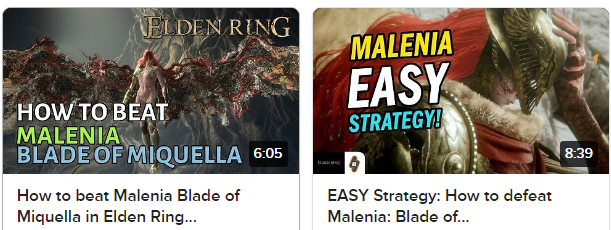
But continue.
All of this can be overwhelming to anyone, especially if this is your first game in the genre. It has seen even some of the most seasoned gamers choosing to abandon it for the simple lack of familiarity and comparatively simple structure other games are able to offer. When the biggest defining feature of your game is how insanely hard it is, you are sure to scare off a few customers. The pay off for those who choose to stay and rise to the challenge, rarely regret their decision though.
The difficulty of these games are without a doubt the biggest barrier to entry for most. A quick search online will show a flood of posts from new users venting their frustration and inability to tackle the challenges these games present. Soulsborne games differ so much from traditional games where players are forced to throw out what they think they know and adapt in an entirely new way. It truly becomes a sink or swim situation where you have to take the time to learn the game and respect its systems in order to get the most out of it.
This however, is where the “secret sauce” of Soulsborne games actually lie. The seemingly insurmountable challenges these games present offer the highest degree of reward to the players that take the time to learn them.
These are hardcore gamerinos for the tvue gamers who don’t need no easy mode. These aren’t your Mom’s action games. You’re gonna heckin’ die, scrub, and then you’re gonna have fifteen minutes of your life wasted as you navigate your way back to the boss. Git gud.
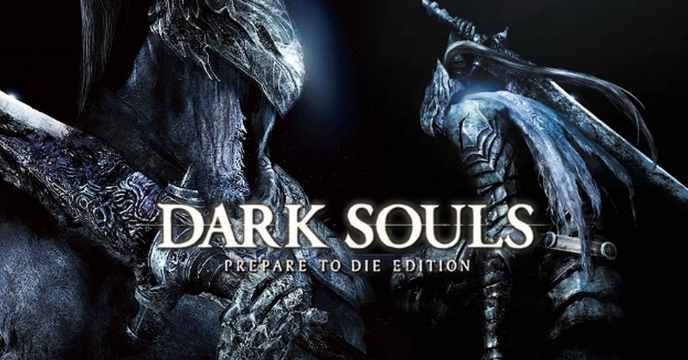
But what does it actually mean to Git Gud at a Soulsborne anyway?
Parrying in Sekiro, attacking to regain health in Bloodborne, and timing dodges in Dark Souls are all vital skills that often take entire playthroughs to truly understand. Many people who give up on these games do so before the combat has the moment of “clicking” for them where the pieces fall into place and they can see the expertly designed rhythm behind the flow of combat offered in these titles.
Parrying? Timing dodges? That timed jump in Sekiro? Hitting the attack button after taking damage in Bloodborne? This reminds me of something…
Could it really be that Soulsbornes have the strategic depth of a quicktime event?
The fact that succeeding has to be earned by the player by respecting the gameplay systems at hand means that every step in progression and victory feels like it was rightfully deserved. These games can be punishing, but only if you choose to brute force your way through them rather than taking the time to learn and use the tools given to you. It is a feeling that is unmatched when you beat your first boss, or finally make it past a difficult area because you took the time to learn the patterns, timing, and rhythm behind the combat. One of the best parts about these games though, is how many people in the community are willing to help you get there.
You gotta learn when to hit the right button, through trial and error, or watching a guide. It’s sort of like playing Guitar Hero on easy mode, but you don’t get to see the button prompts.
It’s easy to think that Soulsborne Enjoyers are underselling their own game genre. After all, if these games are nothing more than a tedious process of learning boss patterns well enough to reliably press the dodge/parry button at the right time, then any retard with enough patience could beat them.
What these games present to those that do though, is an opportunity to experience something that is vastly different from the norm. It offers a fantastically unique gameplay loop that is defined by it’s difficult nature. While these games have their challenges they can often be beaten by anyone given they have the willingness to persevere and the desire to learn and adapt.

There is a relevant comment from “D_RAiL,” underneath the article.

Miyazaki’s Midwits will bloviate all day long about how difficult the Soulsborne games are. However, they occasionally argue that, ackshually, the games are super easy, and anyone can beat them. These two claims sound contradictory, but that’s only because they’ve redefined tedium as difficulty.
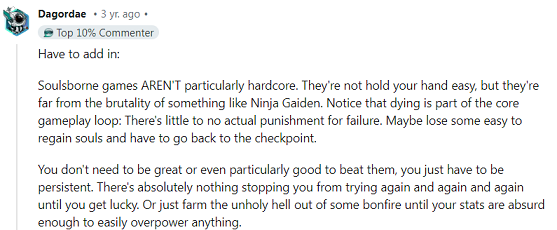
Soulsborne games AREN’T particularly hardcore. They’re not hold your hand easy, but they’re far from the brutality of something like Ninja Gaiden. Notice that dying is part of the core gameplay loop: There’s little to no actual punishment for failure. Maybe lose some easy to regain souls and have to go back to the checkpoint.
You don’t need to be great or even particularly good to beat them, you just have to be persistent. There’s absolutely nothing stopping you from trying again and again and again until you get lucky. Or just farm the unholy hell out of some bonfire until your stats are absurd enough to easily overpower anything.
You don’t need to be good. You just need to have zero respect for your own time, and be willing to spend ten hours dying to some random bullshit before you figure out the exact, precise time that you’re supposed to press the circle button for any given attack.
I really want to stress that it’s also not the difficulty that necessarily turns me off. I really love difficult games. Ninja Gaiden Black is a top 5 game for me, and I almost always play games on higher difficulties. But I’ll be more specific and state some of the reasons why I end up stopping.
- In the first few hours of the game I feel like I am replaying areas over and over again. I spend maybe 15-20 minutes slaying regular enemies, face a boss, die to said boss, and then start again killing the regular enemies. Now I get death is a part of the gameplay loop but I just get bored playing the same 20 minutes over and over again.
- The menus do not seem intuitive to me. I’m not really sure the nuances of what I’m looking at or what information I should be gaining from these menus. Maybe I’m too conditioned with games from the last 10-15 years but I always feel confused by the menus.
- I don’t think I really understand the “dance” of souls games. I am someone very used to character action games a la Ninja Gaiden, Bayonetta, God of War etc., and I understand Souls games are very different, but I don’t know if I’m approaching combat in the “right” way either mechanically or even mentally. To me the combat feels kind of clunky and slow, which I know is part of expectation management but I want to know the reason why so many love these games for the combat in particular.
OP isn’t kidding about the obnoxious process of simply returning to the boss fight. Below is an exercise in hand holding a tutorial helping Dark Souls players get back to the first real boss in that game, the Taurus Demon. That gauntlet is comprised of ten boring minutes killing trash mobs. Every time you die to him you have to do this again. If you die to him just ten times, you’ll have spent approximately an hour and a half simply getting to the boss.
It’s quite likely that you’ll die to him ten or more times, because he’s an overly hard-hitting boss with a gimmick that you can easily miss. Engaging with him normally is an actual fight, but you can skip that by repeatedly climbing up a ladder in the middle of a fight, and repeatedly bonking him on the head.
It doesn’t feel like you have enough time to climb the ladder in the middle of the fight, since the Taurus Demon is pretty fast. However, he just stands there and politely watches you climb the ladder unless you’re at the very bottom. Even though his giant club is literally clipping through the tower right where you are, he has the courtesy to not swing it.
“How To Souls,” shows us how it’s done.
She runs her character all the way to the other side of the arena and back, dodging one boss swipe each way. Then she climbs the ladder, and drops on his head. She repeats this three times, to get his health nice and low.
The fight is finished by her running in place with her head pretty much inside the Demon’s ballsack, repeatedly slashing at his scrotum. At one point the Demon swipes at her, but she exploits invincibility frames and poorly designed hitboxes by rolling against his ballsack to avoid damage. A few more nutshots and the fight is over.
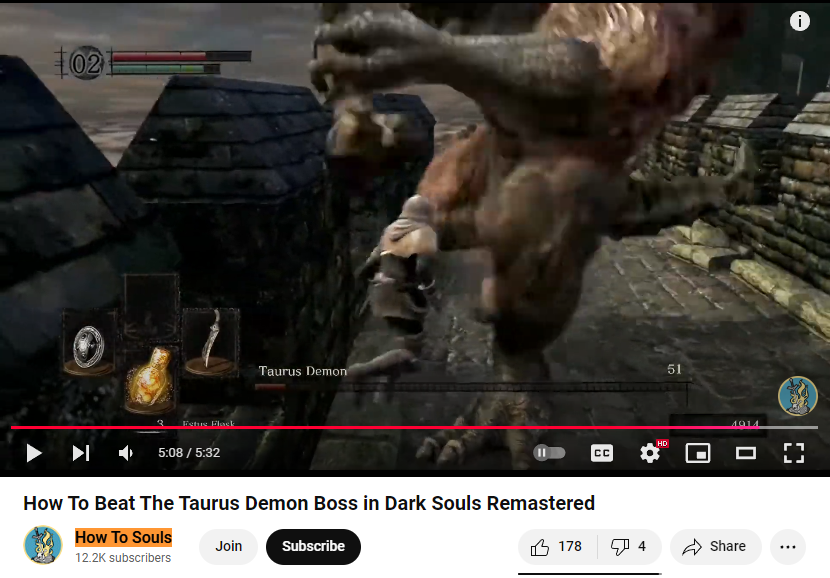
Scrotum attack engaged.
By the way, she isn’t even good at dodging the boss’ attacks. She gets hit on two separate occasions when running from one side of the bridge to the other, and almost dies both times.
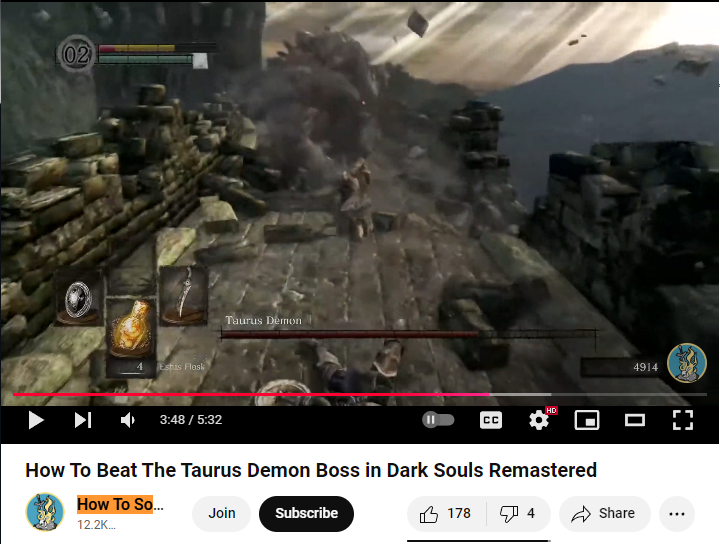
One of the hits reminded me that the camera in Dark Souls is a perfectly oiled machine that always functions properly. I especially like how, in the middle of a fight against a boss that will two shot you, the camera manages to capture neither the boss, nor the player character. The bad camera work is a feature, because it raises the skill gap.
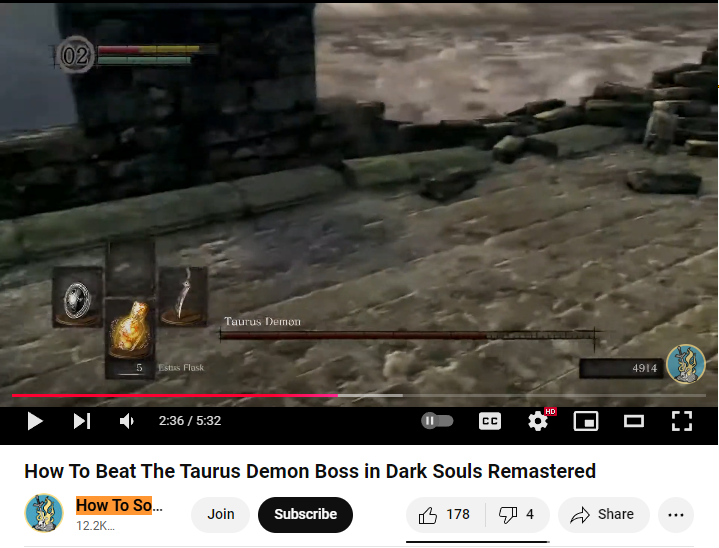
Normally, I wouldn’t blame someone for getting hit in a Dark Souls game. However, this is a guide from someone named “How To Souls,” and they’re objectively bad at fighting the boss. They only won by exploiting some unintuitive, janky cheese, first by bonking the boss’s head, then by holocausting his balls.
In no way, shape, or form is this difficult. Once this technique has been shown, any toddler could do this. However, if you don’t use these ridiculous cheese strategies, prepare to die over and over again. Until such time as you Git Gud embrace the cheese, you can look forward to another fifteen minutes of your life being wasted every time The Lord Of Jank two shots you.
Now, we could give the player a save point right before the boss. This has been standard practice in game design for decades. However, that’s because most games aren’t hardcore enough to ask the player to climb a ladder a few times and roll into a ballsack after watching a guide.
Steam (Sekiro Community General Discussions):
Difficult VS TediousSo is this game actually challenging with gameplay or is it another dodge simulator where enemies are bullet sponges that can one shot you? Like are we talking Ninja Gaiden skill challenge or dodge simulator like the souls games?
The reason so many Soulsborne DisEnjoyers bring up Ninja Gaiden, is because Soulsborne games are basically what you would get if you started with that game, and made it worse in every conceivable way. Start by removing all combat polish, from graphical and sound effects, to deeper gameplay systems.
Continue by making the combat sluggish, and add ten minute long boss runbacks for no reason. Throw in an absolute mess of a story, a terrible menu, poor framerate, horribly implemented input buffering, and a few other idiosyncrasies, and you’ve got yourself a Soulsborne.
I played Ninja Gaiden Black as a kid, and found it frustratingly difficult. However, it never made me replay the same fifteen minutes of braindead, tedious combat just to get back to the boss and get one shot by some stupid anime bullshit. There were NG bosses that took me an entire evening to beat, but 95% of my time was spent actually fighting them. That’s because the boss runbacks were ten seconds long, not ten minutes long.
In Dork Souls you can spend ten minutes getting back to a boss just to watch him two shot you in five seconds with some janky bullshit. There’s nothing “difficult” about this. It’s just the game deliberately wasting your time.
The combat systems in Soulsbornes would be downright unacceptable, were they sold as action games. Frankly, they’re unacceptable anyways. For example, there is almost 200 milliseconds of latency between pressing the dodge button, and actually dodging.
This is caused by two separate issues. First, the framerate is inconsistent and low, and the lower the framerate the higher the input latency. Second, all the Soulsbornes dating back to Demons Souls share the same nonsensical control scheme. For some insane reason they overloaded the dodge button.
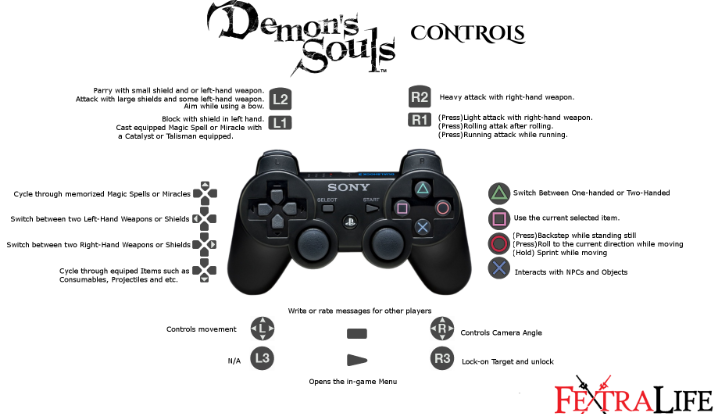
What this means is that the game can’t let you dodge when you press the dodge button. It needs to wait until you release the dodge button, which will undoubtedly be dozens of milliseconds later. This is in a game series where you can get killed by many bosses in one hit, if you mistime your dodge roll.
Commenter “Sand9577”.
I found a guy who makes all the same (obvious) points I’m making here.
I can’t really sum it up better than @doktorkumpel9691 in the comments.
I get that controller schemes can be hard, but this is a problem that Ninja Gaiden solved a decade prior. You don’t have to ape NG’s solution, which works out to a two button press tied to blocking. There are plenty of obvious solutions to this problem.
For example, you could have the roll come out immediately, and turn into a sprint if the player continues holding down the circle button. Or you could combine the use item (square) and switch from two handed to one handed commands (triangle) into one button, which frees up triangle or square for sprint/dodge. Or have dodge come out automatically when the player is locked on to an enemy.
It’s not that difficult to come up with a solution that works for your game. Yet, after fifteen years, FromSoftware are still forcing players to do precision rolls with needlessly horrible controls that add a varying amount of latency, up to roughly two hundred milliseconds. This is okay, genius even, because Miyazaki has reframed sluggish combat with poor controls as “deliberate.”
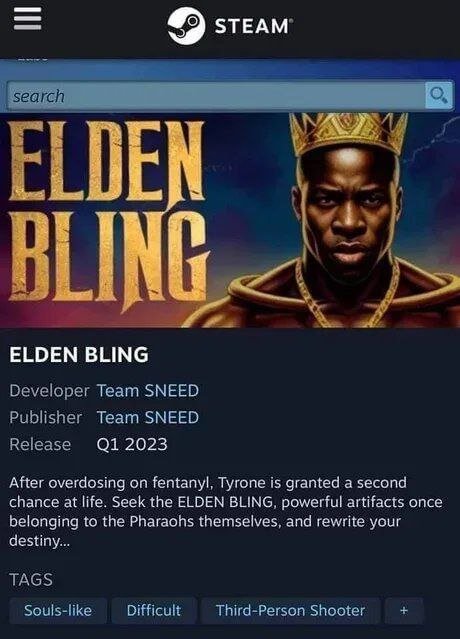
I want to reference a comment from “SanctuaryReintegrate,” from the original input latency video.
Input reading is what enables an AI opponent to perfectly and instantly reacts to everything you do. It’s a cheap and lazy way of increasing the difficulty to whatever level is desired by the game developer.
So of course Elden Ring has it to a comical degree.
For the record, it’s not difficult to hide even simplistic input reading. All you have to do is introduce a bit of randomness, where the boss punishes the move after a varying delay. For example, when you pull out your estus flask to heal, the boss waits between 200-500 milliseconds to attack you, and occasionally does something else entirely.
To really sell the illusion, we also have the boss semi-randomly throw out their response, such as a dodge back or a fireball/attack, which makes it feel like they’re trying to predict your behaviour, and guessing incorrectly. This also avoids another problem where the boss just stands there looking at you, doing nothing until it’s time to frame perfectly react to something you do.
User “Keen7youtubeistoast796”, brings up something else.
You see, this kind of input-reading I can deal with. What I absolutely hate, is when a boss does a 12-hit-combo, and if I don’t do anything, they leave it at 12. As soon as I hit an attack-button, suddenly there is attack number 13.
What? You’re telling me that you don’t like bosses frame perfectly reading your inputs to randomly counter-punish your punish on them? Git gud, scrub.
Fromsoft fanboys occasionally point out that the game technically doesn’t read your inputs, it reads your animations. That’s such a dumb argument that I figured I needed to screencap a few examples from the above video, lest you accuse me of strawmanning.
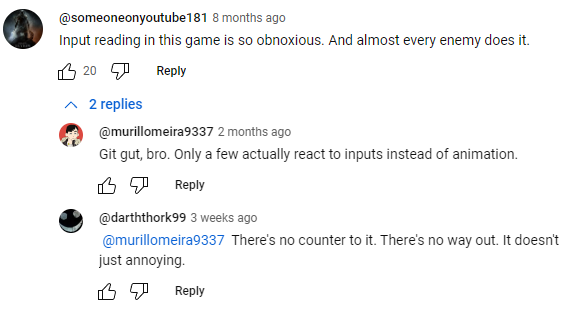
Input reading in this game is so obnoxious. And almost every enemy does it.
– User @someoneonyoutube18
Git gud, bro. Only a few react to inputs instead of animation.
– User @murillomeira9337
Thank God someone set that casual straight.
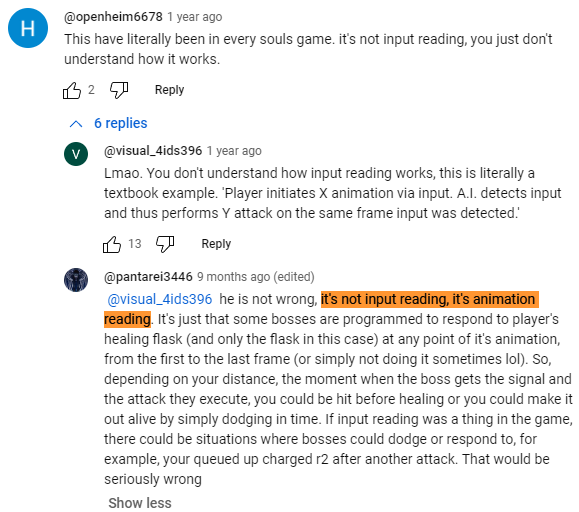 User @pantarei3446 jumps in to educate yet another casual.
User @pantarei3446 jumps in to educate yet another casual.
It’s not input reading, it’s animation reading. It’s just that some bosses are programmed to respond to the player’s healing flask (and only the flask in this case) at any point of it’s[sic] animation, from the first to the last frame (or simply not doing it sometimes lol).
The problem with input reading is the AI reacting to the player’s inputs on the same frame. However, Elden Ring has the AI react to the player’s animation on the same frame. Bosses do this so quickly that they start punishing the player before the avatar has even taken out the healing flask, as shown in this video. Because this is technically not input reading, it’s good.

Does this remind anyone of anything?
There’s a great comment by “Sardette,” again from the original input latency video.
Yes, that’s right. If you press the dodge button too late, the game will store your input, let you get hit, and then automatically dodge a second later. And remember, the dodging has – needlessly – 200 milliseconds of lag, so you can go from full health to dead just because you didn’t compensate for the sluggish controls hard enough.
The point of the video is to show that if you input a dodge before an attack lands, and you take damage before the animation starts, your character will 100% roll after the stagger animation ends, which could be up to a second or more later than when you first pressed the button, even without any further inputs.
This is absolutely awful as it is unwanted inputs in a fast paced action game, where an unwanted roll will most of the time get you hit by another attack, especially in boss fights.
The best part of his video is that he also shows the input latency screwing him over.
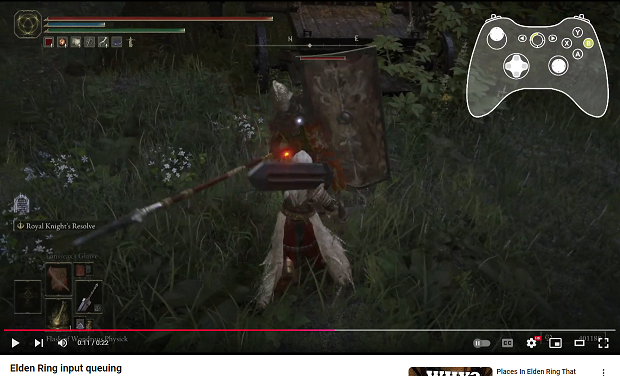
Here he presses the dodge button a full six frames (100ms) before he gets hit by the shield, which glitches right through his character, who has yet to start rolling.
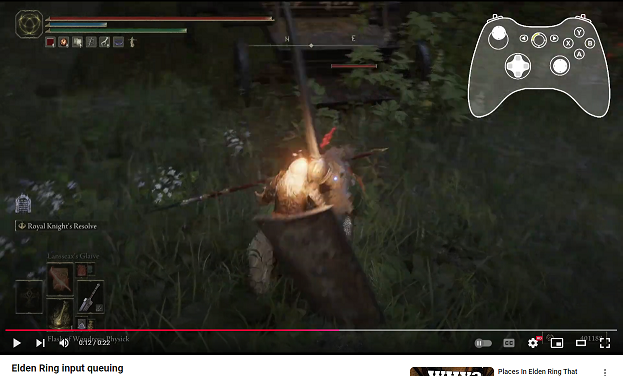
His character spends more than a second stunned after the hit.
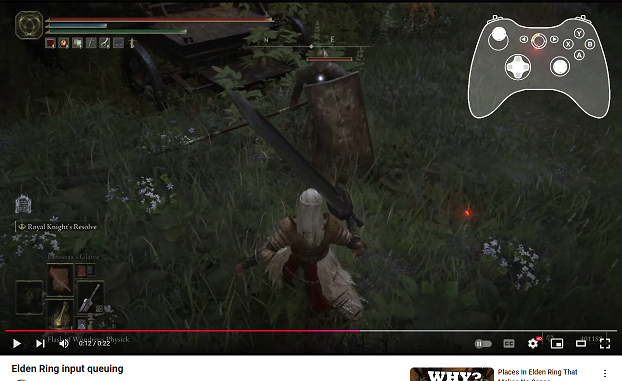
Before, with zero additional input, finally getting that roll out. In this case, that’s directly towards the enemy, so they can punish him again for free.
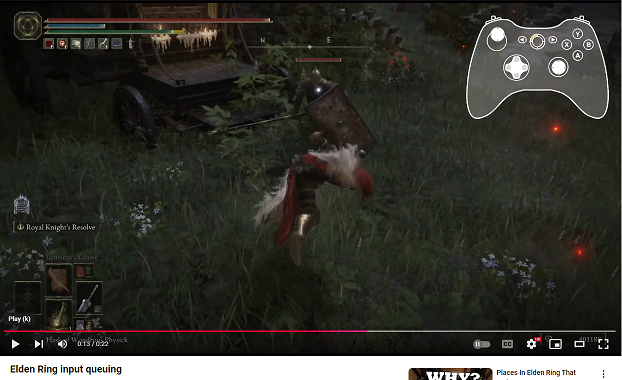
Input buffering in moderation is needed in any game that doesn’t let the character interrupt animations. For instance, think of a first person shooter where you can reload a magazine based weapon. Often in these games you can interrupt the reloading by firing. This doesn’t actually make any logical sense, but if it works for gameplay then it’s fine.
However, there is a problem. The player often wants to start firing their weapon, melee’ing something, or switching weapons, the very first frame after the reloading has finished. If they fire even one frame too early they will interrupt the reloading process and have to start all over again, which is obviously not their intention. If they wait too long, to ensure reloading has finished, then they’ve been forced to compensate for an annoying lack of UI polish.
We can partially solve this problem by not allowing the player to fire during the last bit of reloading. This ensures that, once they get perhaps 90% of the way through reloading, it always finishes, something we can reasonably infer is the intention of the player. But now have a smaller, yet still significant problem, which is that if they press the fire/melee button even just one frame too early, the game will now eat their input and not do anything.
The last part of our solution is input buffering. We store their command that they can’t do just yet (fire/melee/change weapons) in a buffer, and execute this command as soon as possible. That way, if the gun is 50 milliseconds from finishing the reload and they try switching weapons, they’ll never die because that command got eaten, which is unbearably frustrating.
That is the point of input buffering. It exists to fix a situation where the game would have otherwise eaten the player’s input. It does not exist to do anything else, like “force the player to be deliberate with their actions,” or “punish the player for panic tapping the dodge button twice.” It certainly doesn’t exist to ensure that the dodge you got hitstunned out of comes out one second later.
Correctly implementing input buffering does not require 9000 IQ programmers. All you need to do is store the command with a timestamp, and drop it if it’s too old. This is downright trivial.
If that weren’t bad enough, plenty of people report that the game just decides to eat their inputs sometimes.
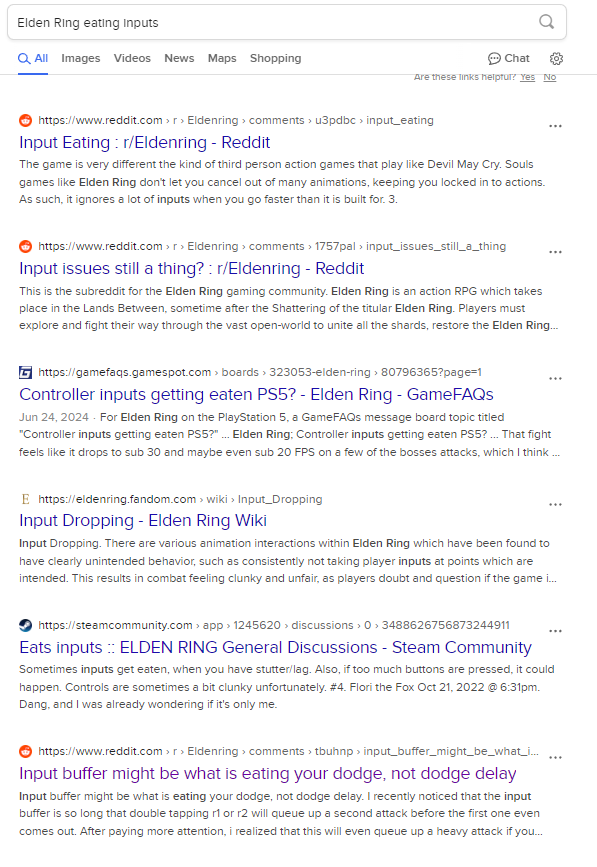
This is the pinnacle of gaming. Broken controls in service of combat where the optimal strategy is to roll into the ballsack of a boss clipping through the world geometry after you bonked him on the head a few times. Oh, and when he kills you, the game forces you to play through ten minutes of trash mobs before you can once again attempt to button mash his scrotum to death.
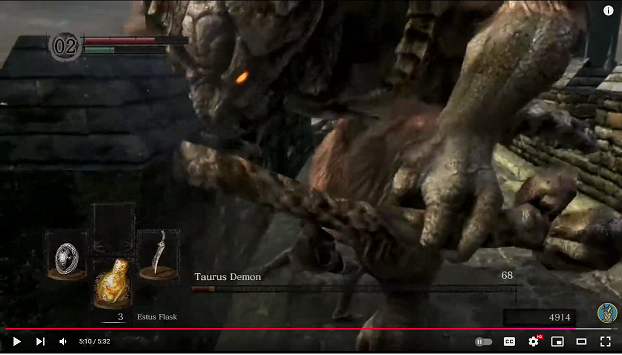
Imagine going from the boss battles in Devil May Cry to this?
I always assumed that Soulsborne fans were never exposed to real character action games, whether they be Ninja Gaiden, Devil May Cry, God Hand, Bayonetta, etcetera. This made it somewhat forgivable that they praised the garbage combat in these games so much. Compared to the average RPG combat system, Soulsbornes are a decent step up.
But apparently, I was wrong. There are some people with a fetish for depthless jank. We see that in the comment below, which is the first response in that Steam thread referenced at the beginning of this article.
Dodge simulator? Not sure what you mean, I hate Ninja Gaiden but I love Souls. Anyways, its all personal preference. I would wait till it comes out, because it looks very different from Souls but it may be similar. So, if you want to make an informed decision then you should wait till launch then ask us.

For the record, the hardest boss FromSoftware ever created can be beaten by pressing the summon button and then hiding in a corner.
Soulsborne combat is the incompetent mess that you’d expect from a tiny indie studio making their first action game. This article was supposed to be about higher order details, but I realized that I couldn’t talk about the finer points of the combat system without referencing the elephant in the room. Your reward for tolerating all that jank is to play a glorified quicktime event.
We’ll have to save the analysis of that for the next article.







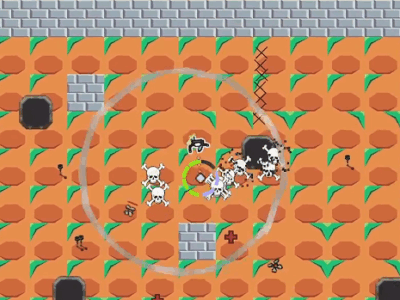
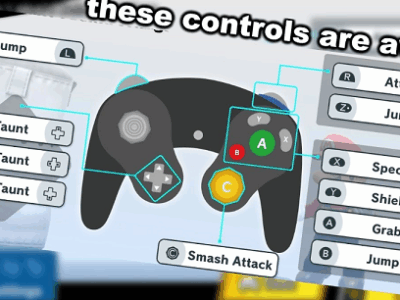







The biggest illusion of these games to the public is that these games have a huge difficulty barrier. It’s more that people approach these games incorrectly and the rest is just timing and pattern recognition.